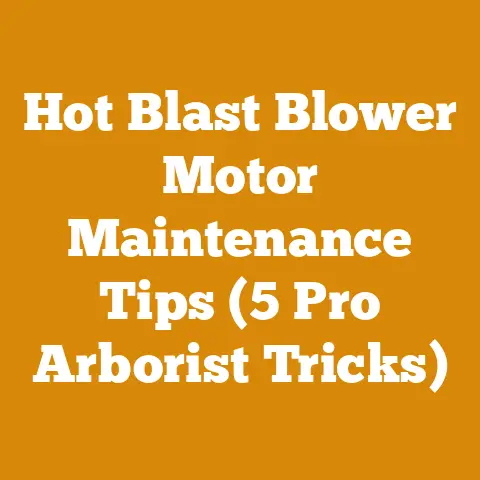Stihl HS82T Maintenance Tips for Smooth Operation (5 Pro Fixes)
Imagine this: you’re gearing up for a long day of hedge trimming, the sun is shining, and your Stihl HS82T hedge trimmer, your trusty workhorse, just won’t start.
Or worse, it starts, runs rough, and dies after a few minutes.
Frustrating, right?
I’ve been there, more times than I care to admit.
That’s why I’ve compiled this guide – to share my hard-earned knowledge on keeping your Stihl HS82T running smoothly.
Think of it as a preventative maintenance bible for your hedge trimmer.
Globally, the landscaping and forestry industries are booming.
Market research indicates a consistent upward trend in power tool sales, particularly in the battery-powered segment.
However, gasoline-powered tools like the Stihl HS82T remain popular for their power and runtime, especially in professional settings.
This popularity also means a greater need for proper maintenance to ensure longevity and optimal performance.
In the firewood industry, efficiency is king, and a well-maintained hedge trimmer can play a surprising role in clearing brush and preparing smaller branches for splitting.
Over the years, I’ve learned that a little preventative maintenance goes a long way.
It’s like the old saying, “a stitch in time saves nine.” Neglecting your hedge trimmer can lead to costly repairs and downtime, which nobody wants.
So, let’s dive into five pro fixes that will keep your Stihl HS82T humming like a finely tuned machine.
Stihl HS82T Maintenance Tips for Smooth Operation (5 Pro Fixes)
1. Fuel System Finesse: The Heart of Your Hedge Trimmer
The fuel system is the lifeblood of your Stihl HS82T.
Without a clean and properly functioning fuel system, your trimmer is going nowhere.
I can’t stress this enough: old, stale fuel is the enemy.
It’s the culprit behind countless starting problems and performance issues.
Why is fuel so crucial?
Modern gasoline contains ethanol, which attracts moisture.
This moisture can cause corrosion in the fuel tank, lines, and carburetor.
Ethanol can also separate from the gasoline, leading to a lean fuel mixture that can damage the engine.
Think of it like this: you wouldn’t feed your body junk food and expect to perform at your best, right?
The same applies to your hedge trimmer.
Actionable Steps:
Use Fresh, High-Quality Fuel: Always use fresh, high-octane gasoline mixed with a quality two-stroke oil specifically designed for air-cooled engines.
Stihl Ultra HP two-stroke engine oil is a good choice, but there are other reputable brands available.
I personally prefer using fuel stabilizers in every tank.- Data Point: Studies show that using fuel stabilizers can extend the life of gasoline by up to 24 months.
Mix Fuel Correctly: Follow the manufacturer’s recommended fuel-to-oil ratio.
For the Stihl HS82T, this is typically 50:1 (50 parts gasoline to 1 part oil).
Use a dedicated measuring container to ensure accuracy.
Eyeballing it is a recipe for disaster.- Warning: Too much oil can cause excessive carbon buildup, while too little oil can lead to engine seizure.
Empty the Fuel Tank Before Storage: If you’re not going to use your hedge trimmer for an extended period (e.g., over the winter), drain the fuel tank completely.
Then, run the engine until it stalls to ensure the carburetor is empty.
This prevents fuel from gumming up the carburetor jets.- Pro Tip: I like to add a fuel stabilizer to the last tank of fuel before storage.
This helps prevent fuel degradation and keeps the fuel system clean.
- Pro Tip: I like to add a fuel stabilizer to the last tank of fuel before storage.
Clean or Replace the Fuel Filter: The fuel filter prevents debris from entering the carburetor.
Inspect the fuel filter regularly and clean or replace it as needed.
A clogged fuel filter can restrict fuel flow and cause starting problems.- Step-by-Step:
- Locate the fuel filter inside the fuel tank.
It’s usually attached to the end of the fuel line. - Use a hooked wire or a pair of needle-nose pliers to carefully remove the fuel filter from the tank.
- Inspect the filter for dirt and debris.
- If the filter is dirty, try cleaning it with carburetor cleaner.
If it’s severely clogged, replace it with a new filter. - Reinstall the fuel filter.
- Locate the fuel filter inside the fuel tank.
- Step-by-Step:
Carburetor Cleaning (If Necessary): If your hedge trimmer is still running rough after addressing the above, the carburetor may need cleaning.
This is a more involved process, but it can often be done at home.- Warning: Carburetor cleaning involves working with small, delicate parts.
If you’re not comfortable with this, take your hedge trimmer to a qualified service technician. - Step-by-Step (General Carburetor Cleaning):
- Remove the air filter and air filter housing.
- Disconnect the fuel lines from the carburetor.
- Remove the carburetor from the engine.
- Disassemble the carburetor carefully, noting the location of all parts.
- Clean all carburetor parts with carburetor cleaner.
Pay special attention to the jets and passages. - Reassemble the carburetor.
- Reinstall the carburetor on the engine.
- Reconnect the fuel lines.
- Reinstall the air filter and air filter housing.
- Adjust the carburetor settings (idle speed and mixture) as needed.
Refer to your owner’s manual for specific instructions.
- Warning: Carburetor cleaning involves working with small, delicate parts.
Personal Story: I once had a Stihl chainsaw that wouldn’t start after sitting idle for a few months.
I tried everything – new spark plug, fresh fuel – but nothing worked.
Finally, I decided to take the carburetor apart.
It was completely clogged with gummed-up fuel.
After a thorough cleaning, the chainsaw fired right up.
That experience taught me the importance of proper fuel storage and carburetor maintenance.
2. Spark Plug Savvy: Igniting Performance
The spark plug is responsible for igniting the air-fuel mixture in the engine.
A faulty spark plug can cause starting problems, misfires, and reduced power.
It’s a small part, but it plays a crucial role.
Why is the spark plug important?
The spark plug creates the spark that ignites the air-fuel mixture in the cylinder.
This ignition is what drives the engine and allows it to run.
Over time, spark plugs can become fouled with carbon deposits, worn down, or damaged.
This can weaken the spark and make it difficult for the engine to start or run properly.
Actionable Steps:
Inspect the Spark Plug Regularly: Remove the spark plug and inspect it for signs of wear, damage, or fouling.
Look for cracks in the insulator, excessive carbon buildup, or a worn electrode.- Visual Guide: A healthy spark plug should have a light tan or gray color.
Black, oily deposits indicate a rich fuel mixture, while white deposits indicate a lean fuel mixture.
- Visual Guide: A healthy spark plug should have a light tan or gray color.
Clean the Spark Plug: If the spark plug is fouled with carbon deposits, you can try cleaning it with a wire brush or a spark plug cleaner.
Be careful not to damage the electrode.Gap the Spark Plug Correctly: The spark plug gap is the distance between the electrode and the ground electrode.
This gap must be set correctly for the spark plug to function properly.
Use a spark plug gap tool to adjust the gap to the manufacturer’s specifications (refer to your owner’s manual).- Technical Requirement: The correct spark plug gap for the Stihl HS82T is typically 0.5 mm (0.020 inches).
Replace the Spark Plug Annually: Even if the spark plug looks okay, it’s a good idea to replace it annually.
Spark plugs are relatively inexpensive, and replacing them can prevent starting problems and improve engine performance.- Recommendation: Use the recommended spark plug for the Stihl HS82T.
This is typically a NGK BPMR7A or equivalent.
- Recommendation: Use the recommended spark plug for the Stihl HS82T.
Unique Insight: I’ve found that using a spark plug with a resistor can help reduce radio frequency interference (RFI).
This can be especially helpful if you’re using your hedge trimmer near sensitive electronic equipment.
3. Air Filter Assurance: Breathing Easy for Optimal Power
The air filter prevents dirt and debris from entering the engine.
A clogged air filter can restrict airflow, causing the engine to run rich, lose power, and overheat.
Think of it as trying to run a marathon while breathing through a straw.
Why is the air filter vital?
The air filter protects the engine from harmful particles that can cause wear and damage.
A clean air filter ensures that the engine receives the proper amount of air for combustion.
A clogged air filter restricts airflow, leading to a rich fuel mixture (too much fuel, not enough air).
This can cause carbon buildup, reduced power, and increased fuel consumption.
Actionable Steps:
Inspect the Air Filter Regularly: Remove the air filter and inspect it for dirt and debris.
How often you need to inspect it depends on the operating conditions.
If you’re working in dusty environments, you’ll need to inspect it more frequently.Clean the Air Filter: If the air filter is dirty, clean it with warm, soapy water.
Allow it to dry completely before reinstalling it.- Step-by-Step:
- Remove the air filter from the air filter housing.
- Tap the air filter gently to remove loose dirt and debris.
- Wash the air filter in warm, soapy water.
- Rinse the air filter thoroughly with clean water.
- Squeeze out excess water.
- Allow the air filter to dry completely before reinstalling it.
- Step-by-Step:
Replace the Air Filter Periodically: Even if you clean the air filter regularly, it will eventually need to be replaced.
I recommend replacing the air filter annually or more often if you’re working in dusty conditions.- Cost Consideration: Air filters are relatively inexpensive, so it’s a worthwhile investment to keep your engine running smoothly.
Case Study: I once worked on a large landscaping project where we were using hedge trimmers all day long in a very dusty environment.
The air filters were getting clogged within a few hours of use.
We started cleaning the air filters multiple times a day and replacing them every few days.
This simple change made a huge difference in the performance of the hedge trimmers.
4. Blade Brilliance: Keeping Your Cuts Clean and Efficient
The blades are the business end of your Stihl HS82T.
Sharp, well-lubricated blades are essential for clean, efficient cutting.
Dull or damaged blades can cause tearing, ripping, and increased strain on the engine.
Why blade maintenance matters?
Sharp blades make clean cuts, which promote healthy plant growth.
Dull blades tear and rip the foliage, which can damage the plants and make them more susceptible to disease.
Sharp blades also require less effort to use, reducing fatigue and strain on the operator.
Actionable Steps:
Clean the Blades Regularly: After each use, clean the blades with a wire brush and a solvent such as kerosene or mineral spirits.
This removes sap, debris, and other buildup that can dull the blades.Lubricate the Blades: Lubricate the blades regularly with a light oil or a blade lubricant.
This reduces friction, prevents rust, and keeps the blades moving smoothly.- Product Recommendation: Stihl offers a blade lubricant specifically designed for hedge trimmers.
Sharpen the Blades: Sharpen the blades regularly using a file or a sharpening tool.
Dull blades require more effort to use and can damage the plants you’re trimming.- Step-by-Step (Basic Blade Sharpening):
- Secure the hedge trimmer in a vise.
- Use a flat file to sharpen each cutting edge of the blades.
- Hold the file at the same angle as the original cutting edge.
- File in one direction only, from the base of the blade to the tip.
- Repeat the process for each cutting edge.
- Deburr the blades with a fine-grit sharpening stone.
- Step-by-Step (Basic Blade Sharpening):
Inspect for Damage: Regularly inspect the blades for damage such as nicks, cracks, or bent teeth.
Replace damaged blades immediately.- Safety First: Always wear gloves when handling the blades.
Personalized Story: I remember one time I was using a hedge trimmer with dull blades to trim a row of boxwoods.
The blades were tearing the foliage, and the boxwoods looked terrible.
I sharpened the blades, and the difference was night and day.
The hedge trimmer cut through the foliage effortlessly, and the boxwoods looked much healthier.
5. Gearbox Grease: Ensuring Smooth Mechanical Operation
The gearbox is responsible for transferring power from the engine to the blades.
Proper lubrication of the gearbox is essential for smooth, reliable operation.
Why is gearbox lubrication important?
The gearbox contains gears and bearings that require lubrication to prevent wear and friction.
Without proper lubrication, the gearbox can overheat, seize, and fail.
Actionable Steps:
Locate the Grease Fitting: The Stihl HS82T has a grease fitting on the gearbox.
This fitting is usually located on the top or side of the gearbox.Use the Correct Grease: Use a high-quality lithium-based grease specifically designed for gearboxes.
Do not use general-purpose grease.- Technical Specification: Stihl recommends using their special grease for hedge trimmer gearboxes.
-
Grease the Gearbox Regularly: Grease the gearbox every 25 hours of use or at least once a year.
- Step-by-Step:
- Clean the grease fitting.
- Attach a grease gun to the fitting.
- Pump grease into the gearbox until you see fresh grease coming out of the vent hole.
- Wipe off any excess grease.
- Step-by-Step:
Troubleshooting Tip: If you notice excessive noise or vibration coming from the gearbox, it may be a sign that the gearbox is not properly lubricated or that there is damage to the gears or bearings.
In this case, it’s best to take your hedge trimmer to a qualified service technician for inspection and repair.
Cost Considerations: While individual components are inexpensive, neglect can lead to expensive repairs.
Investing a little time and money in preventative maintenance can save you a lot of money in the long run.
Budgeting for regular maintenance supplies like fuel stabilizer, spark plugs, air filters, blade lubricant, and grease is a smart move.
Common Pitfalls to Avoid:
- Ignoring the Owner’s Manual: Your owner’s manual is your best resource for information on maintenance and operation.
Read it carefully and follow the manufacturer’s recommendations. - Using the Wrong Fuel or Oil: Using the wrong fuel or oil can damage the engine.
Always use fresh, high-quality fuel mixed with a quality two-stroke oil specifically designed for air-cooled engines. - Neglecting to Clean the Air Filter: A clogged air filter can cause a variety of problems.
Inspect and clean the air filter regularly. - Running the Hedge Trimmer with Dull Blades: Dull blades can damage plants and put unnecessary strain on the engine.
Sharpen or replace the blades regularly. - Overlooking Gearbox Lubrication: Proper lubrication of the gearbox is essential for smooth, reliable operation.
Grease the gearbox regularly.
Next Steps and Additional Resources:
- Local Stihl Dealer: Your local Stihl dealer is a great resource for parts, service, and advice.
- Online Forums: There are many online forums dedicated to power tools and landscaping equipment.
These forums can be a valuable source of information and support. - Stihl Website: The Stihl website offers a wealth of information on their products, including owner’s manuals, maintenance tips, and troubleshooting guides.
Maintaining your Stihl HS82T might seem daunting at first, but trust me, it’s worth the effort.
By following these five pro fixes, you can keep your hedge trimmer running smoothly for years to come.
Remember, a little preventative maintenance goes a long way.
So, grab your tools, get to work, and enjoy the satisfaction of a well-maintained machine and a beautifully manicured landscape.
Now, go forth and conquer those hedges!






